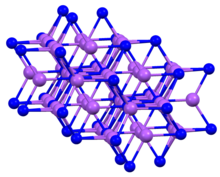Sodium phosphide

| |
| Names | |
|---|---|
| Other names
sodium phosphide,
trisodiophosphine | |
| Identifiers | |
3D model (
JSmol ) |
|
| ChemSpider | |
ECHA InfoCard
|
100.031.834 |
| EC Number |
|
PubChem CID
|
|
| UNII | |
| |
| |
| Properties | |
| Na3P | |
| Molar mass | 99.943 g/mol |
| Appearance | red crystals |
| Density | 1.74 g/cm3 |
| Melting point | 650 °C (1,202 °F; 923 K) |
| hydrolysis | |
| Solubility | insoluble in liquid CO2 |
| Structure | |
hexagonal a = 4.9512 Å c = 8.7874 Å | |
| around P 5 near neighbours, trigonal bipyramid [1] | |
| Related compounds | |
Other anions
|
sodium arsenide sodium nitride |
Other cations
|
aluminium phosphide lithium phosphide potassium phosphide |
Except where otherwise noted, data are given for materials in their standard state (at 25 °C [77 °F], 100 kPa).
| |
Sodium phosphide is the
In addition to Na3P, five other binary compositions of sodium and phosphorus are known: NaP, Na3P7, Na3P11, NaP7, and NaP15.[3]
Structure and Properties
The compound crystallizes in a hexagonal motif, often called the sodium arsenide structure.[4] Like K3P, solid Na3P features pentacoordinate P centers.[1]
Preparation
The first preparation of Na3P was first reported in the mid-19th century. French researcher, Alexandre Baudrimont prepared sodium phosphide by treating molten sodium with phosphorus pentachloride.[5]
Many different routes to Na3P have been described. Due to its flammability and toxicity, Na3P (and related salts) is often prepared and used in situ. White phosphorus is reduced by sodium-potassium alloy:[6]
- P4 + 12 Na → 4 Na3P
Phosphorus reacts with sodium in an autoclave at 150 °C for 5 hours to produce Na3P.[7]
Alternatively the reaction can be conducted at normal pressures but using a temperatures gradient to generate nonvolatile NaxP phases (x < 3) that then react further with sodium.
Uses
Sodium phosphide is a source of the highly reactive phosphide anion. The material is insoluble in all solvents but reacts as a slurry with acids and related electrophiles to give derivatives of the type PM3:[6]
- Na3P + 3 E+ → E3P (E = H, Me3Si)
The trimethylsilyl derivative is volatile (b.p. 30-35 C @ 0.001 mm Hg) and soluble. It serves as a soluble equivalent to "P3−".
Indium phosphide, a semiconductor arises by treating in-situ generated "sodium phosphide" with indium(III) chloride in hot N,N’-dimethylformamide as solvent. In this process, the phosphide reagent is generated from sodium metal and white phosphorus, whereupon it immediately reacts with the indium salt:[10]
- Na3P + InCl3 → InP + 3NaCl
Sodium phosphide is also employed commercially as a

Precautions
Sodium phosphide is highly dangerous releasing toxic
References
- ^ .
- .
- ISBN 0-12-352651-5
- ^ Baudrimont (1864). Annales de chimie et de physique. 2: 13.
{{cite journal}}: Missing or empty|title=(help) - ^ ISBN 9780470132586.
- .
- PMID 11196860.
- ^ Peterson, D. J. 1967. US Patent No. 3,397,039.
- .
- ^ Atarashi, Y.; Fukumoto, O. Japanese Patent No. JP 42,006,269.
- ^ Kenneth L Barbalace. "Sodium phosphide". Chemical Database.
